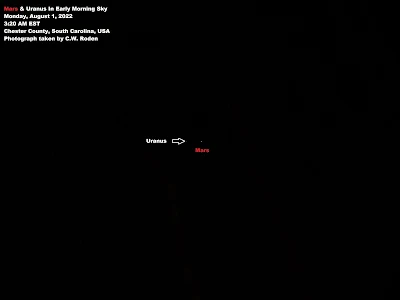Good morning fellow stargazers!
Very early this morning -- or very last last night, depending on how y'all look at it -- after a couple of evenings of mostly cloudy skies, I was fortunate to capture a very close conjunction of the planets Mars and Uranus.
The first shot between the branches of the tree is the Red Planet, our closest planetary neighbor, with a very small, barely visible dot about one-degree to the left. That little faded dot is the elusive 7th planet of our solar system, Uranus. I only lightly highlighted Uranus in the first photo, but in the second close-up photo, you can just see the 5.8 magnitude distant planet just to the left of 0.2 magnitude bright Mars.
Without a good lens, or pair or binoculars, spotting
Uranus with the naked eye along is next to impossible unless you know
exactly where to look. In this case we have Mars as an excellent
starting point as the two planets will be close together for the next
few nights.
Of course, by "close together" I'm only referring to how we view the two planets from here on the surface of the Earth. In reality, both Mars and Uranus are over 1.6 billion miles (or about 17.7 AU) apart at the moment in respect to their distance from the Sun.
Also, despite being more distant from our world, Uranus is actually much larger than either Earth, or Mars. With a diameter of 31,510 miles (or 50,723 kilometers), Uranus is four times larger than the Earth and the third largest planet in the Solar System. By contrast, Mars is much smaller at 4,212 miles (or 6.779 km) in diameter.
Uranus is also a ringed world like Saturn, although seeing these rings from Earth, even with a good telescope, is next to impossible. These rings were discovered by Cornell University astronomers James L. Elliot, Edward W. Dunham, and Jessica Mink on Thursday, March 10, 1977, although German astronomer William Herschel had also reportedly observed what he suspected were the rings in 1789. The rings were later photographed by the Voyager 2 spacecraft during its historic flyby on Friday, January 24, 1986.
In addition to its thin rings, Uranus has 15 known small moons orbiting the planet -- the largest of these is Titania, the eighth-largest moon in the Solar System at 891 miles (or 1,578 km) in diameter.
If you want to see Uranus (and please keep your minds out of the gutter folks, LOL!) the planet will start to move just above and past Mars in the early morning sky in the Northern Hemisphere over the next few days; but be advised you need a really got set of eyes and a good camera lens, telescope, or binoculars if you want to spot it.
Thanks again and I hope y'all enjoyed my photos and presentation. As always have a wonderful Dixie Day and be sure to keep your eyes to the night skies, y'all!
 |
| Photo taken by the Voyager 2 space probe of Uranus and its rings during its flyby of the planet on January 24, 1986. |


No comments:
Post a Comment